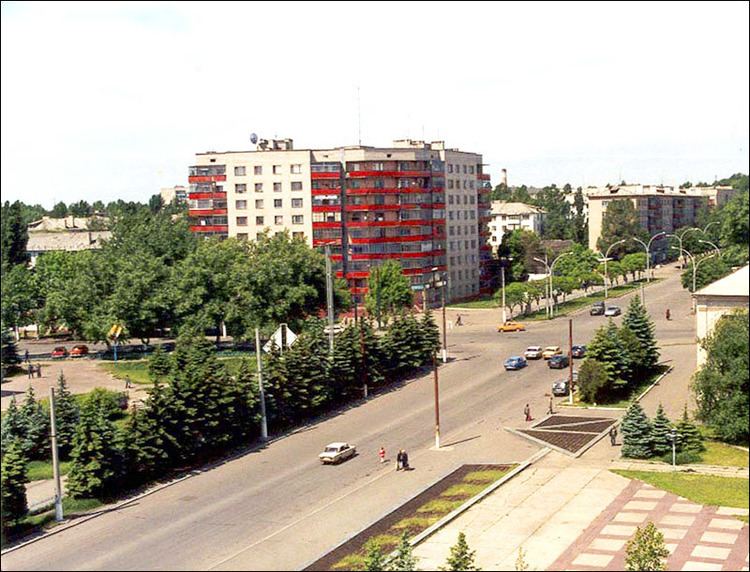Postal code 94613 Population 54,640 (2013) | Time zone EET (UTC+2) Area 61.3 km² Local time Sunday 10:56 PM | |
 | ||
Founded 1895 (miners' settlement) Weather -1°C, Wind SW at 13 km/h, 76% Humidity | ||
Ukraine war armed russian don cossacks arrive to seize antratsyt ukraine
Antratsyt or Antratsit (Ukrainian: Антрацит; Russian: Антрацит) is a city in Eastern Ukraine. It is located in the southern part of the Luhansk Oblast (region). Antratsyt is incorporated as a city of oblast significance and is the center of Antratsyt Municipality which includes six urban-type settlements. It also serves as the administrative center of Antratsyt Raion (district), though it does not belong to the raion. Population: 54,640 (2013 est.).
Contents
- Ukraine war armed russian don cossacks arrive to seize antratsyt ukraine
- Map of Antratsyt Luhansk Oblast Ukraine
- Origin
- History
- Demographics
- Geography
- Climate
- Religion
- Sports
- Education
- Economy
- Transportation
- Law and government
- Notable people
- References
Map of Antratsyt, Luhansk Oblast, Ukraine
Origin
Antratsyt is appropriately named after its large supply of anthracite, a type of coal valuable because of its high carbon content and low levels of impurities, making it especially desirable for home heating and metallurgical applications.
History
Evidence from archeological finds and burial mounds from 30,000 BC indicates the Saltovo-Mayaki were Antratsyt's earliest ancestors. Since the Saltovo-Mayaki were nomadic, the area was left uninhabited and considered part of the Wild Fields. It was only in the late 16th century that the Don Cossacks claimed the area, protecting it from Tatar and Mongol raids, and started farming settlements. In 1874, Cossack Ivan Dvuzhenov found coal nearby and by 1904, the Antratsyt Bokovsky Coal Mine was built. A small settlement grew around the mine and soon after, the Kolberg Coal Mine was built in 1912, allowing the settlement to grow and prosper. In 1920, the town was officially named Bokovo-Antratsyt after its first coal mine, which was later shortened to Antratsyt (1962). With the creation of the Soviet Union in 1922, the town became under the Ukrainian Soviet Socialist Republic's rule. As an important center for coal extraction, the city was made a rayon center in 1936. From 1942 to 1943, the city was occupied by Nazi troops. Led by I.E. Voropayeva, the city retaliated and regained its freedom. A quarter of Antratsyt's population at the time (7100) were awarded military honors and of those awarded, six were given the title Hero of the Soviet Union and three were given the Order of Glory.
Since 2014, Antratsyt has been located on the territory of the Luhansk People's Republic and is not controlled by Ukrainian authorities.
Demographics
The 2010 Ukrainian Census reported that Antratsyt had a population of 78,137. The ethnic makeup was 50.5% Ukrainian, 47.5% Russian, 1% Tartar, and 1% Belorussian. 85.9% spoke Russian, 11.1% Ukrainian, 0.1% Romani, 0.1% Armenian and 0.1% Belarusian as their native language.
Geography
Antratsyt is located 90 kilometres (56 mi) south of Lugansk, 130 kilometres (81 mi) north-east of Donetsk, and 32 kilometres (20 mi) west of the Rostov region's border in Russia. Even though Antratsyt is rich in water resources, which include the Nagolna River and the Mius River as well as several artificial lakes, residents are only allowed running water between the times of 18:00 to 21:00. Antratsyt's City Council presides over following outskirt villages: Bokovo-Platov, Berhny Nagolchik, Dubovsky, Krepensky, Schetovo, Kamenny, and Shahta Tsentralnaya.
Climate
Antratsyt's climate is moderate continental with hot summers and cold winters. July temperatures range from 21.8 °C to 35 °C while January temperatures range from −6 °C to −15 °C. Annual precipitation is 400–500 mm.
Religion
Orthodox Christianity is the predominant religion in Antratsyt with five churches (Holy Protection, St. Alexander Nevsky, St. George, St. Kazan, Mother of God "Skoroposlushnitsa" Nina Apostles Church). Other active religions include Jehovah Witnesses, Baptists, and Islam. The Church of Alexander Nevsky in the outskirt village Bokovo-Platov is considered an architectural monument as it was built in 1954 and survived damage when outlawed by the Soviets.
Sports
Healthy living is important to the people of Antratsyt. There are many sports teams, music bands, dance groups, and clubs held either in the sports complex "Swimming Pool" or the adjoining stadium.
Education
There are many primary/secondary schools and preschools, including a specialized school of foreign languages.
Higher education institutions (level 5 accreditation):Economy
Located in Ukraine's heavily industrialized Donbas, Antratsyt's coal mining industry makes up 75% of the city's total production and comprises four mines (Partizanskaya Coal Mine, Komsomolskaya Coal Mine, Krepenskaya Coal Mine, "50 years of Soviet Ukraine" Coal Mine) and two mechanical repair plants (Luganskugleremont, Slavsant). The remaining economy consists of engineering companies (Ltd. "Pneumatics", AOZT "Prokat" AOOT "Color", JSC "Antratsyt Greenhouses", SE "Etalon-thermal") and food manufacturing companies (Branch LLC "Caravan" bakery, CE "Temp Ltd").
Transportation
Marshrutkas (private minibuses) and electric trolley buses provide public transportation and taxis are available as well. There is also a railway station that is part of the Karahash Donetsk Railway.
Law and government
Antratsyt's government consists of a mayor and a city council with 46 members. Members of the city council are divided into six committees:
- Rules and Deputy Ethics
- Budget
- Industry, Transportation, and Communications
- Domestic, Housing, and Communal Services
- Land Relations and Urban Planning
- Education, Culture, Health and Sports
